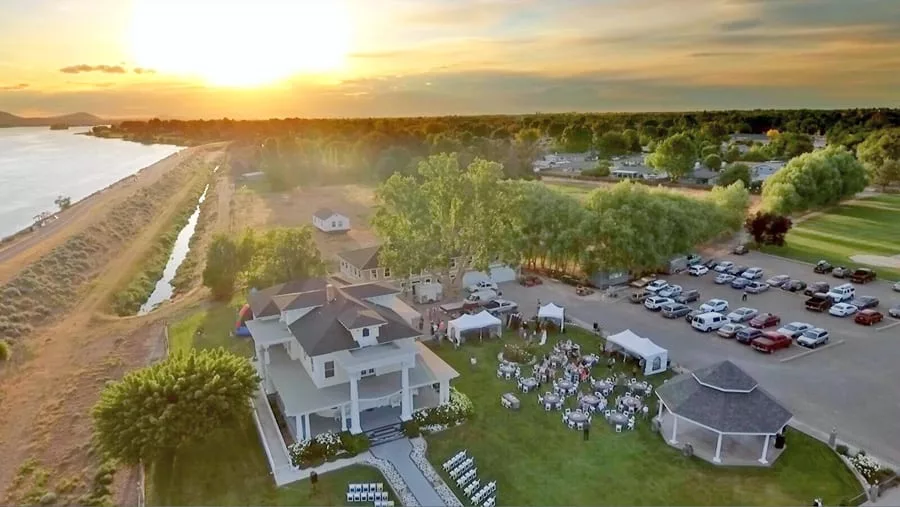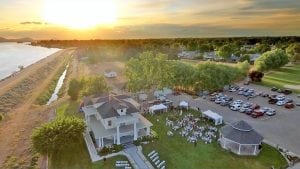
Home » Business owners expect drone technology to soar in the Tri-Cities
Business owners expect drone technology to soar in the Tri-Cities

November 15, 2016
Four years ago, Justin Coronado and Bryan Monarch started an aerial production and photography company using drones to make commercials for businesses.
“We did some aerial video work for Nelson Irrigation located in Walla Walla, made some promo videos for a couple of different agricultural companies, and also made one for a company that builds levelers for combines,” Monarch said. “It was back when drones were just starting to show up. It was very uncommon to see people using one.”
Since many people had yet to realize the value of using drones for marketing and research, Coronado and Monarch kept their day jobs at Lamb Weston and spent their nights and weekends—and sometimes their vacation time—on projects for the side business they named UpAngle LLC.
“We both had really stable, solid jobs, and people thought we were crazy to quit,” Coronado said. “But we decided if we’re going to do this, the time was now. So in April of this year, we pulled the trigger. There’s a lot of opportunity, and with the drone technology that’s becoming more available, we know more competition will come to the area.”
UpAngle is not the only business in the Tri-Cities using drones to offer unique perspectives and information to clients.
Ryan Scott of West Richland’s Firefly Solutions, which does commercial photo and video production, started using drones about four years ago.

“It adds so much to the production value,” said Scott, who specializes in personal video production services, such as weddings. “It adds to a larger body of work—such as establishing a shot of a venue like the Moore Mansion. You only use 15 seconds of videography in a 15-minute movie, but it gives the viewer an idea of what they’re looking at. I’ll take a drone over the river, over the Moore Mansion, and it’s one of those things where the viewer might not know why it’s cool, but it’s something they haven’t seen before or haven’t seen such high production in a personal setting.”
Drones allow Scott to go higher than the crane he owns, which maxes out at 12 feet. The Federal Aviation Administration limits drones that weigh 55 pounds or less to a maximum of 400 feet in the air and speeds of no more than 100 miles per hour.
This past summer, the FAA released new, comprehensive regulations regarding drone use. Within weeks of the FAA’s rollout, the agency received 12,000 applications for commercial operation licenses. While the FAA considered requiring drone operators to have manned aircraft pilot licenses, the agency opted not to in order to spur business growth and innovation.
“We got ahead of the game,” Monarch said. “When (the FAA) posted that they were going to come out with new regulations, we took the aviation test and were ready to go on day one.”
Along with video production, such as commercials for businesses, UpAngle focuses on topographical mapping services and agricultural imaging, using a fixed-wing eBee Ag drone that cost around $20,000.
Monarch said the agricultural side is one of the biggest opportunities for drones right now because it provides growers with a plant health assessment, such as whether a plant or crop is in need of fertilizer or pesticides. In the past, that information has primarily been delivered by planes or satellites.
“The difference with drones compared to plane or satellite is resolution,” said Monarch. “You’re looking at a square per pixel, and satellites are looking on average about 15 meters—or 45 feet—per pixel, and that covers a big section of their field that isn’t essentially the same. With drones, the resolution is just mind blowing. We are typically imaging at 1.6 inches or less per pixel, and the superior resolution lets farmers make more decisions. A comparison would be like if I gave you a smartphone from 2002 and then gave you the brand new iPhone7.”
Better decisions lead to better crop production, which is a hot topic in the agricultural world, Coronado said.
“Based on the current production of food, by 2050, there’s not going to be enough food to feed half of the world’s population due to population growth. That’s a fact put out there by groups that are forecasting growth, and it really ties into why (drone technology) is huge,” Coronado said. “The drone is the new, exciting missing piece of the puzzle that provides incredible amounts of valuable data. We provide a low-cost option and a certain level of accuracy to deliver a product growers are looking for.”
UpAngle’s clientele spans from large-scale agricultural companies to vineyard owners and everything in between.
The company charges $1.75 per acre for a one-operation flight. Its incentive is contract pricing, which provides imagery four times a year, at $1.25 per acre. Coronado said most growers are interested in contract pricing to cover pre-seed, post-seed and post-spray with final imaging completed right before harvest.
“We think the agricultural side is going to propel us to be a really big name in the Northwest,” Coronado said. “Our client lists are getting bigger, and there’s more and more recognizable names now.”
Like most businesses, there are peak seasons, and both UpAngle and Firefly Solutions concur that winter is not big for the drone business.
Coronado and Monarch conduct most of their business out of their homes, but they plan to take advantage of the down season to secure a central office. The ideal location would allow them to test equipment onsite, which means they need to take into consideration air space restrictions near the Tri-Cities Airport in Pasco.
“We want to establish ourselves as the drone service provider of the region, and of the Northwest,” Monarch said. “And the big picture plan for us would be establishing employees in expanded areas.”
For more information about UpAngle, LLC, visit them at: http://upangle.com. Connect with Firefly Solutions at: http://firefly.solutions.
Local News
KEYWORDS november 2016





